Childhood Obesity: Causes, Effects, and Prevention
VerifiedAdded on 2022/12/30
|10
|3755
|4
AI Summary
Childhood obesity is a serious medical condition that affects children and adolescents, leading to various health problems. This article explores the causes, effects, and prevention of childhood obesity, emphasizing the importance of healthy eating habits and physical activity for children's well-being.
Contribute Materials
Your contribution can guide someone’s learning journey. Share your
documents today.
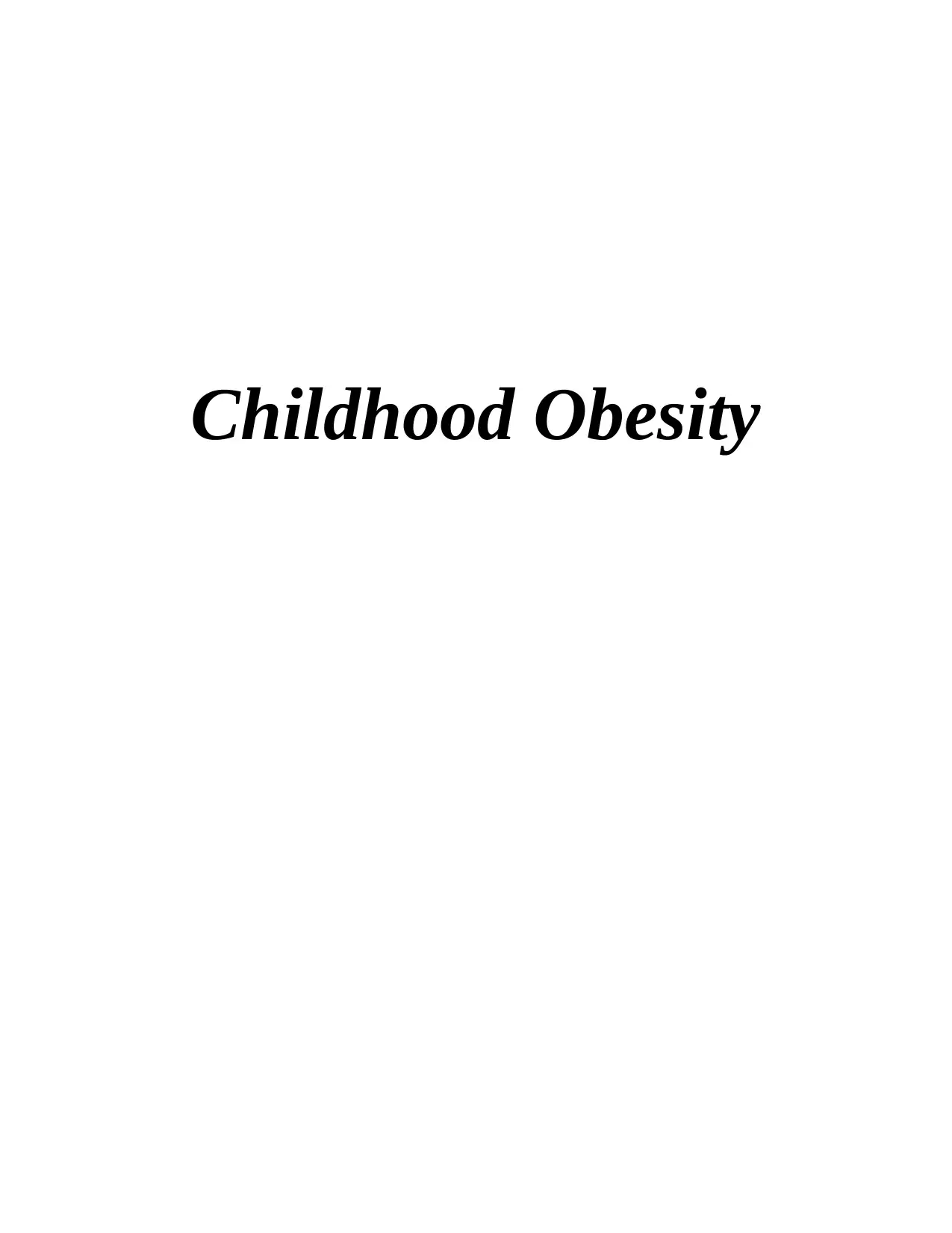
Childhood Obesity
Secure Best Marks with AI Grader
Need help grading? Try our AI Grader for instant feedback on your assignments.
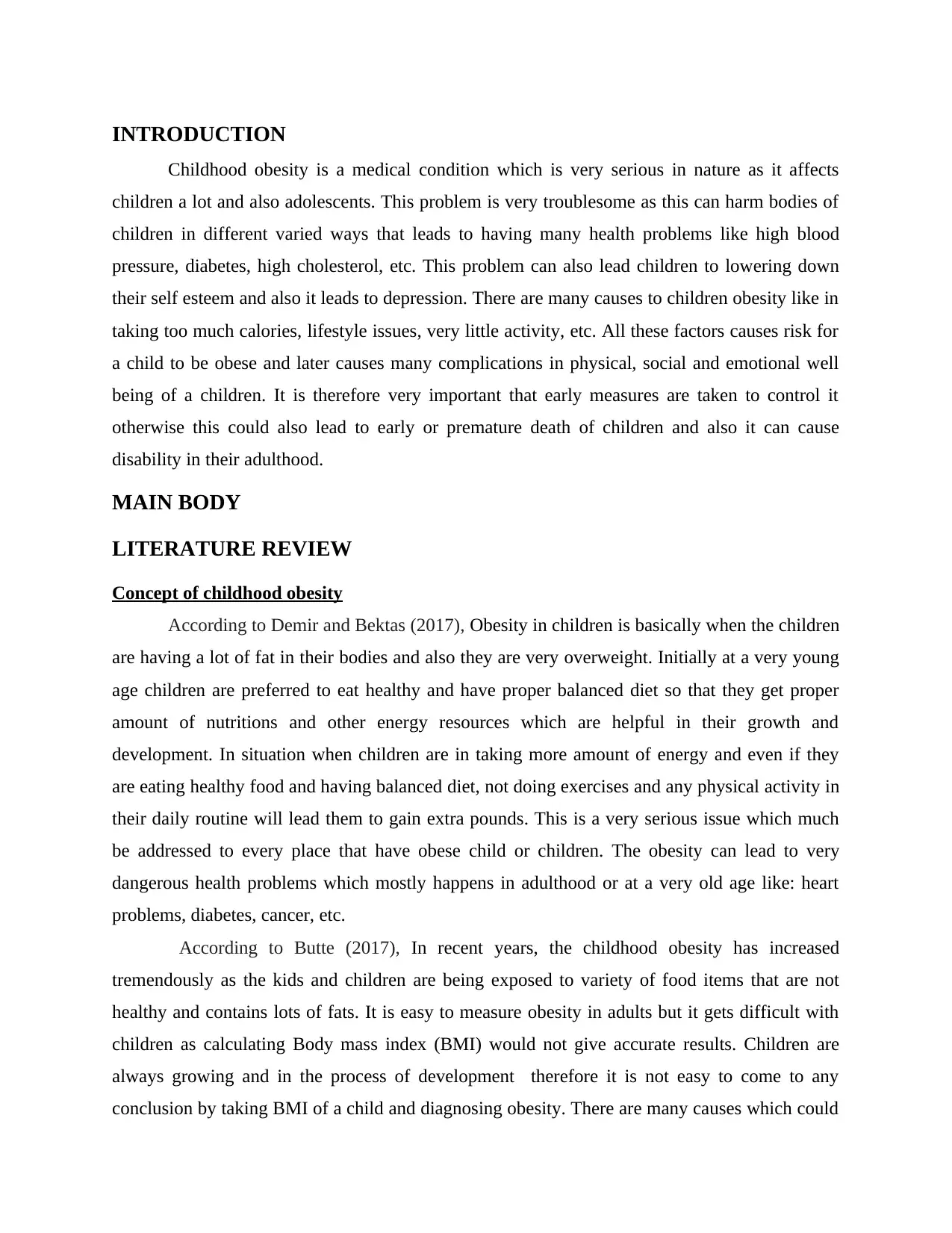
INTRODUCTION
Childhood obesity is a medical condition which is very serious in nature as it affects
children a lot and also adolescents. This problem is very troublesome as this can harm bodies of
children in different varied ways that leads to having many health problems like high blood
pressure, diabetes, high cholesterol, etc. This problem can also lead children to lowering down
their self esteem and also it leads to depression. There are many causes to children obesity like in
taking too much calories, lifestyle issues, very little activity, etc. All these factors causes risk for
a child to be obese and later causes many complications in physical, social and emotional well
being of a children. It is therefore very important that early measures are taken to control it
otherwise this could also lead to early or premature death of children and also it can cause
disability in their adulthood.
MAIN BODY
LITERATURE REVIEW
Concept of childhood obesity
According to Demir and Bektas (2017), Obesity in children is basically when the children
are having a lot of fat in their bodies and also they are very overweight. Initially at a very young
age children are preferred to eat healthy and have proper balanced diet so that they get proper
amount of nutritions and other energy resources which are helpful in their growth and
development. In situation when children are in taking more amount of energy and even if they
are eating healthy food and having balanced diet, not doing exercises and any physical activity in
their daily routine will lead them to gain extra pounds. This is a very serious issue which much
be addressed to every place that have obese child or children. The obesity can lead to very
dangerous health problems which mostly happens in adulthood or at a very old age like: heart
problems, diabetes, cancer, etc.
According to Butte (2017), In recent years, the childhood obesity has increased
tremendously as the kids and children are being exposed to variety of food items that are not
healthy and contains lots of fats. It is easy to measure obesity in adults but it gets difficult with
children as calculating Body mass index (BMI) would not give accurate results. Children are
always growing and in the process of development therefore it is not easy to come to any
conclusion by taking BMI of a child and diagnosing obesity. There are many causes which could
Childhood obesity is a medical condition which is very serious in nature as it affects
children a lot and also adolescents. This problem is very troublesome as this can harm bodies of
children in different varied ways that leads to having many health problems like high blood
pressure, diabetes, high cholesterol, etc. This problem can also lead children to lowering down
their self esteem and also it leads to depression. There are many causes to children obesity like in
taking too much calories, lifestyle issues, very little activity, etc. All these factors causes risk for
a child to be obese and later causes many complications in physical, social and emotional well
being of a children. It is therefore very important that early measures are taken to control it
otherwise this could also lead to early or premature death of children and also it can cause
disability in their adulthood.
MAIN BODY
LITERATURE REVIEW
Concept of childhood obesity
According to Demir and Bektas (2017), Obesity in children is basically when the children
are having a lot of fat in their bodies and also they are very overweight. Initially at a very young
age children are preferred to eat healthy and have proper balanced diet so that they get proper
amount of nutritions and other energy resources which are helpful in their growth and
development. In situation when children are in taking more amount of energy and even if they
are eating healthy food and having balanced diet, not doing exercises and any physical activity in
their daily routine will lead them to gain extra pounds. This is a very serious issue which much
be addressed to every place that have obese child or children. The obesity can lead to very
dangerous health problems which mostly happens in adulthood or at a very old age like: heart
problems, diabetes, cancer, etc.
According to Butte (2017), In recent years, the childhood obesity has increased
tremendously as the kids and children are being exposed to variety of food items that are not
healthy and contains lots of fats. It is easy to measure obesity in adults but it gets difficult with
children as calculating Body mass index (BMI) would not give accurate results. Children are
always growing and in the process of development therefore it is not easy to come to any
conclusion by taking BMI of a child and diagnosing obesity. There are many causes which could
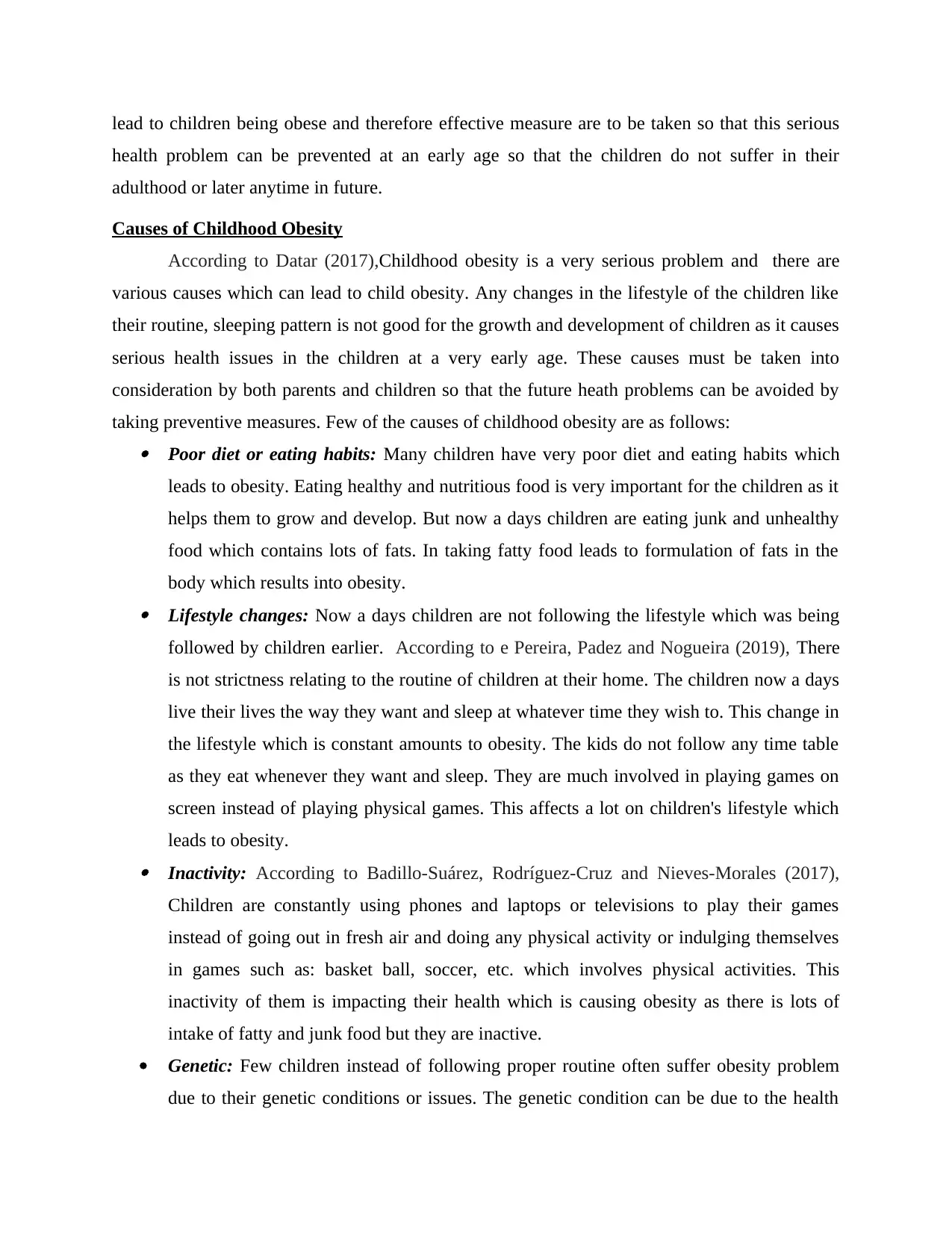
lead to children being obese and therefore effective measure are to be taken so that this serious
health problem can be prevented at an early age so that the children do not suffer in their
adulthood or later anytime in future.
Causes of Childhood Obesity
According to Datar (2017),Childhood obesity is a very serious problem and there are
various causes which can lead to child obesity. Any changes in the lifestyle of the children like
their routine, sleeping pattern is not good for the growth and development of children as it causes
serious health issues in the children at a very early age. These causes must be taken into
consideration by both parents and children so that the future heath problems can be avoided by
taking preventive measures. Few of the causes of childhood obesity are as follows: Poor diet or eating habits: Many children have very poor diet and eating habits which
leads to obesity. Eating healthy and nutritious food is very important for the children as it
helps them to grow and develop. But now a days children are eating junk and unhealthy
food which contains lots of fats. In taking fatty food leads to formulation of fats in the
body which results into obesity. Lifestyle changes: Now a days children are not following the lifestyle which was being
followed by children earlier. According to e Pereira, Padez and Nogueira (2019), There
is not strictness relating to the routine of children at their home. The children now a days
live their lives the way they want and sleep at whatever time they wish to. This change in
the lifestyle which is constant amounts to obesity. The kids do not follow any time table
as they eat whenever they want and sleep. They are much involved in playing games on
screen instead of playing physical games. This affects a lot on children's lifestyle which
leads to obesity. Inactivity: According to Badillo-Suárez, Rodríguez-Cruz and Nieves-Morales (2017),
Children are constantly using phones and laptops or televisions to play their games
instead of going out in fresh air and doing any physical activity or indulging themselves
in games such as: basket ball, soccer, etc. which involves physical activities. This
inactivity of them is impacting their health which is causing obesity as there is lots of
intake of fatty and junk food but they are inactive.
Genetic: Few children instead of following proper routine often suffer obesity problem
due to their genetic conditions or issues. The genetic condition can be due to the health
health problem can be prevented at an early age so that the children do not suffer in their
adulthood or later anytime in future.
Causes of Childhood Obesity
According to Datar (2017),Childhood obesity is a very serious problem and there are
various causes which can lead to child obesity. Any changes in the lifestyle of the children like
their routine, sleeping pattern is not good for the growth and development of children as it causes
serious health issues in the children at a very early age. These causes must be taken into
consideration by both parents and children so that the future heath problems can be avoided by
taking preventive measures. Few of the causes of childhood obesity are as follows: Poor diet or eating habits: Many children have very poor diet and eating habits which
leads to obesity. Eating healthy and nutritious food is very important for the children as it
helps them to grow and develop. But now a days children are eating junk and unhealthy
food which contains lots of fats. In taking fatty food leads to formulation of fats in the
body which results into obesity. Lifestyle changes: Now a days children are not following the lifestyle which was being
followed by children earlier. According to e Pereira, Padez and Nogueira (2019), There
is not strictness relating to the routine of children at their home. The children now a days
live their lives the way they want and sleep at whatever time they wish to. This change in
the lifestyle which is constant amounts to obesity. The kids do not follow any time table
as they eat whenever they want and sleep. They are much involved in playing games on
screen instead of playing physical games. This affects a lot on children's lifestyle which
leads to obesity. Inactivity: According to Badillo-Suárez, Rodríguez-Cruz and Nieves-Morales (2017),
Children are constantly using phones and laptops or televisions to play their games
instead of going out in fresh air and doing any physical activity or indulging themselves
in games such as: basket ball, soccer, etc. which involves physical activities. This
inactivity of them is impacting their health which is causing obesity as there is lots of
intake of fatty and junk food but they are inactive.
Genetic: Few children instead of following proper routine often suffer obesity problem
due to their genetic conditions or issues. The genetic condition can be due to the health
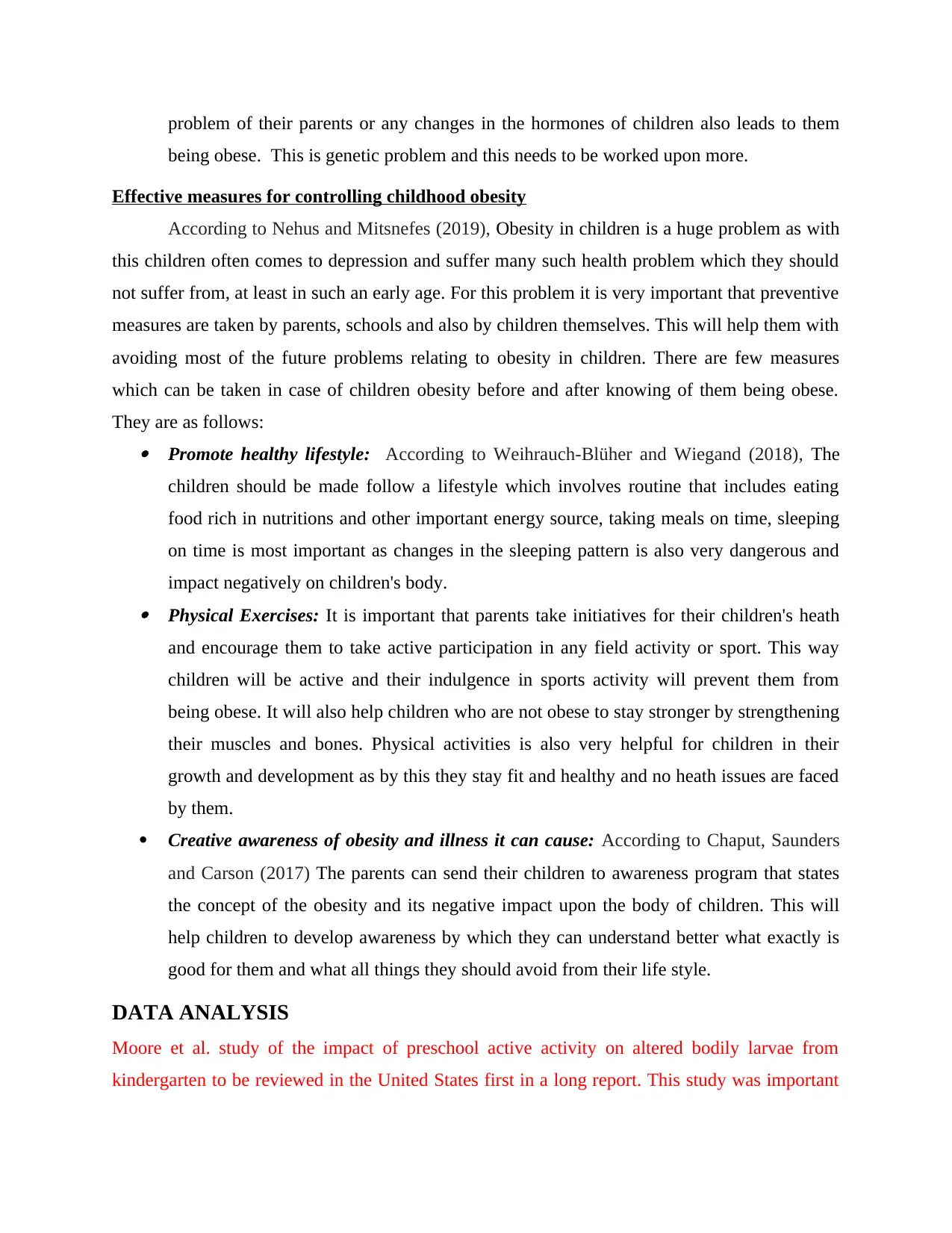
problem of their parents or any changes in the hormones of children also leads to them
being obese. This is genetic problem and this needs to be worked upon more.
Effective measures for controlling childhood obesity
According to Nehus and Mitsnefes (2019), Obesity in children is a huge problem as with
this children often comes to depression and suffer many such health problem which they should
not suffer from, at least in such an early age. For this problem it is very important that preventive
measures are taken by parents, schools and also by children themselves. This will help them with
avoiding most of the future problems relating to obesity in children. There are few measures
which can be taken in case of children obesity before and after knowing of them being obese.
They are as follows: Promote healthy lifestyle: According to Weihrauch-Blüher and Wiegand (2018), The
children should be made follow a lifestyle which involves routine that includes eating
food rich in nutritions and other important energy source, taking meals on time, sleeping
on time is most important as changes in the sleeping pattern is also very dangerous and
impact negatively on children's body. Physical Exercises: It is important that parents take initiatives for their children's heath
and encourage them to take active participation in any field activity or sport. This way
children will be active and their indulgence in sports activity will prevent them from
being obese. It will also help children who are not obese to stay stronger by strengthening
their muscles and bones. Physical activities is also very helpful for children in their
growth and development as by this they stay fit and healthy and no heath issues are faced
by them.
Creative awareness of obesity and illness it can cause: According to Chaput, Saunders
and Carson (2017) The parents can send their children to awareness program that states
the concept of the obesity and its negative impact upon the body of children. This will
help children to develop awareness by which they can understand better what exactly is
good for them and what all things they should avoid from their life style.
DATA ANALYSIS
Moore et al. study of the impact of preschool active activity on altered bodily larvae from
kindergarten to be reviewed in the United States first in a long report. This study was important
being obese. This is genetic problem and this needs to be worked upon more.
Effective measures for controlling childhood obesity
According to Nehus and Mitsnefes (2019), Obesity in children is a huge problem as with
this children often comes to depression and suffer many such health problem which they should
not suffer from, at least in such an early age. For this problem it is very important that preventive
measures are taken by parents, schools and also by children themselves. This will help them with
avoiding most of the future problems relating to obesity in children. There are few measures
which can be taken in case of children obesity before and after knowing of them being obese.
They are as follows: Promote healthy lifestyle: According to Weihrauch-Blüher and Wiegand (2018), The
children should be made follow a lifestyle which involves routine that includes eating
food rich in nutritions and other important energy source, taking meals on time, sleeping
on time is most important as changes in the sleeping pattern is also very dangerous and
impact negatively on children's body. Physical Exercises: It is important that parents take initiatives for their children's heath
and encourage them to take active participation in any field activity or sport. This way
children will be active and their indulgence in sports activity will prevent them from
being obese. It will also help children who are not obese to stay stronger by strengthening
their muscles and bones. Physical activities is also very helpful for children in their
growth and development as by this they stay fit and healthy and no heath issues are faced
by them.
Creative awareness of obesity and illness it can cause: According to Chaput, Saunders
and Carson (2017) The parents can send their children to awareness program that states
the concept of the obesity and its negative impact upon the body of children. This will
help children to develop awareness by which they can understand better what exactly is
good for them and what all things they should avoid from their life style.
DATA ANALYSIS
Moore et al. study of the impact of preschool active activity on altered bodily larvae from
kindergarten to be reviewed in the United States first in a long report. This study was important
Secure Best Marks with AI Grader
Need help grading? Try our AI Grader for instant feedback on your assignments.
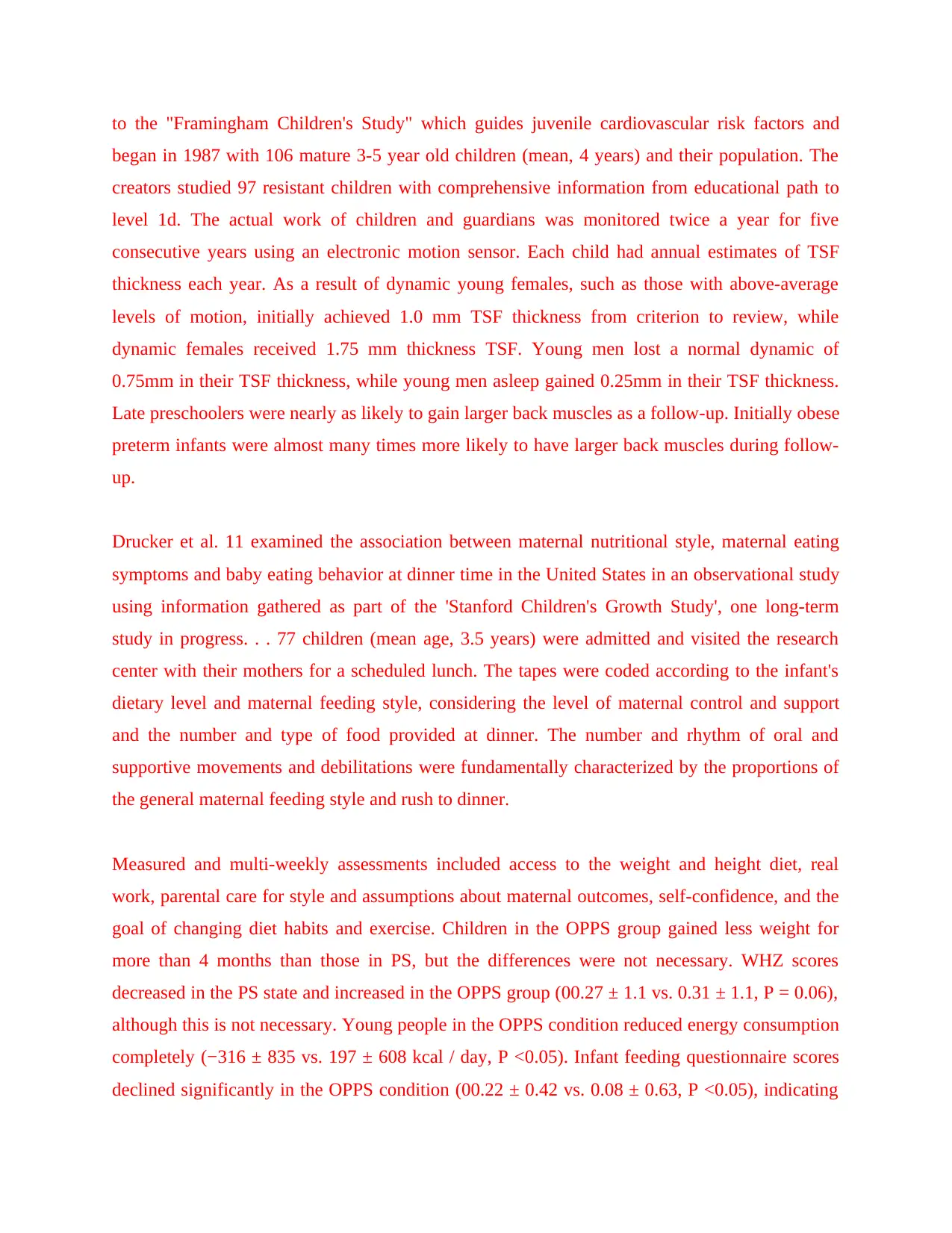
to the "Framingham Children's Study" which guides juvenile cardiovascular risk factors and
began in 1987 with 106 mature 3-5 year old children (mean, 4 years) and their population. The
creators studied 97 resistant children with comprehensive information from educational path to
level 1d. The actual work of children and guardians was monitored twice a year for five
consecutive years using an electronic motion sensor. Each child had annual estimates of TSF
thickness each year. As a result of dynamic young females, such as those with above-average
levels of motion, initially achieved 1.0 mm TSF thickness from criterion to review, while
dynamic females received 1.75 mm thickness TSF. Young men lost a normal dynamic of
0.75mm in their TSF thickness, while young men asleep gained 0.25mm in their TSF thickness.
Late preschoolers were nearly as likely to gain larger back muscles as a follow-up. Initially obese
preterm infants were almost many times more likely to have larger back muscles during follow-
up.
Drucker et al. 11 examined the association between maternal nutritional style, maternal eating
symptoms and baby eating behavior at dinner time in the United States in an observational study
using information gathered as part of the 'Stanford Children's Growth Study', one long-term
study in progress. . . 77 children (mean age, 3.5 years) were admitted and visited the research
center with their mothers for a scheduled lunch. The tapes were coded according to the infant's
dietary level and maternal feeding style, considering the level of maternal control and support
and the number and type of food provided at dinner. The number and rhythm of oral and
supportive movements and debilitations were fundamentally characterized by the proportions of
the general maternal feeding style and rush to dinner.
Measured and multi-weekly assessments included access to the weight and height diet, real
work, parental care for style and assumptions about maternal outcomes, self-confidence, and the
goal of changing diet habits and exercise. Children in the OPPS group gained less weight for
more than 4 months than those in PS, but the differences were not necessary. WHZ scores
decreased in the PS state and increased in the OPPS group (00.27 ± 1.1 vs. 0.31 ± 1.1, P = 0.06),
although this is not necessary. Young people in the OPPS condition reduced energy consumption
completely (−316 ± 835 vs. 197 ± 608 kcal / day, P <0.05). Infant feeding questionnaire scores
declined significantly in the OPPS condition (00.22 ± 0.42 vs. 0.08 ± 0.63, P <0.05), indicating
began in 1987 with 106 mature 3-5 year old children (mean, 4 years) and their population. The
creators studied 97 resistant children with comprehensive information from educational path to
level 1d. The actual work of children and guardians was monitored twice a year for five
consecutive years using an electronic motion sensor. Each child had annual estimates of TSF
thickness each year. As a result of dynamic young females, such as those with above-average
levels of motion, initially achieved 1.0 mm TSF thickness from criterion to review, while
dynamic females received 1.75 mm thickness TSF. Young men lost a normal dynamic of
0.75mm in their TSF thickness, while young men asleep gained 0.25mm in their TSF thickness.
Late preschoolers were nearly as likely to gain larger back muscles as a follow-up. Initially obese
preterm infants were almost many times more likely to have larger back muscles during follow-
up.
Drucker et al. 11 examined the association between maternal nutritional style, maternal eating
symptoms and baby eating behavior at dinner time in the United States in an observational study
using information gathered as part of the 'Stanford Children's Growth Study', one long-term
study in progress. . . 77 children (mean age, 3.5 years) were admitted and visited the research
center with their mothers for a scheduled lunch. The tapes were coded according to the infant's
dietary level and maternal feeding style, considering the level of maternal control and support
and the number and type of food provided at dinner. The number and rhythm of oral and
supportive movements and debilitations were fundamentally characterized by the proportions of
the general maternal feeding style and rush to dinner.
Measured and multi-weekly assessments included access to the weight and height diet, real
work, parental care for style and assumptions about maternal outcomes, self-confidence, and the
goal of changing diet habits and exercise. Children in the OPPS group gained less weight for
more than 4 months than those in PS, but the differences were not necessary. WHZ scores
decreased in the PS state and increased in the OPPS group (00.27 ± 1.1 vs. 0.31 ± 1.1, P = 0.06),
although this is not necessary. Young people in the OPPS condition reduced energy consumption
completely (−316 ± 835 vs. 197 ± 608 kcal / day, P <0.05). Infant feeding questionnaire scores
declined significantly in the OPPS condition (00.22 ± 0.42 vs. 0.08 ± 0.63, P <0.05), indicating
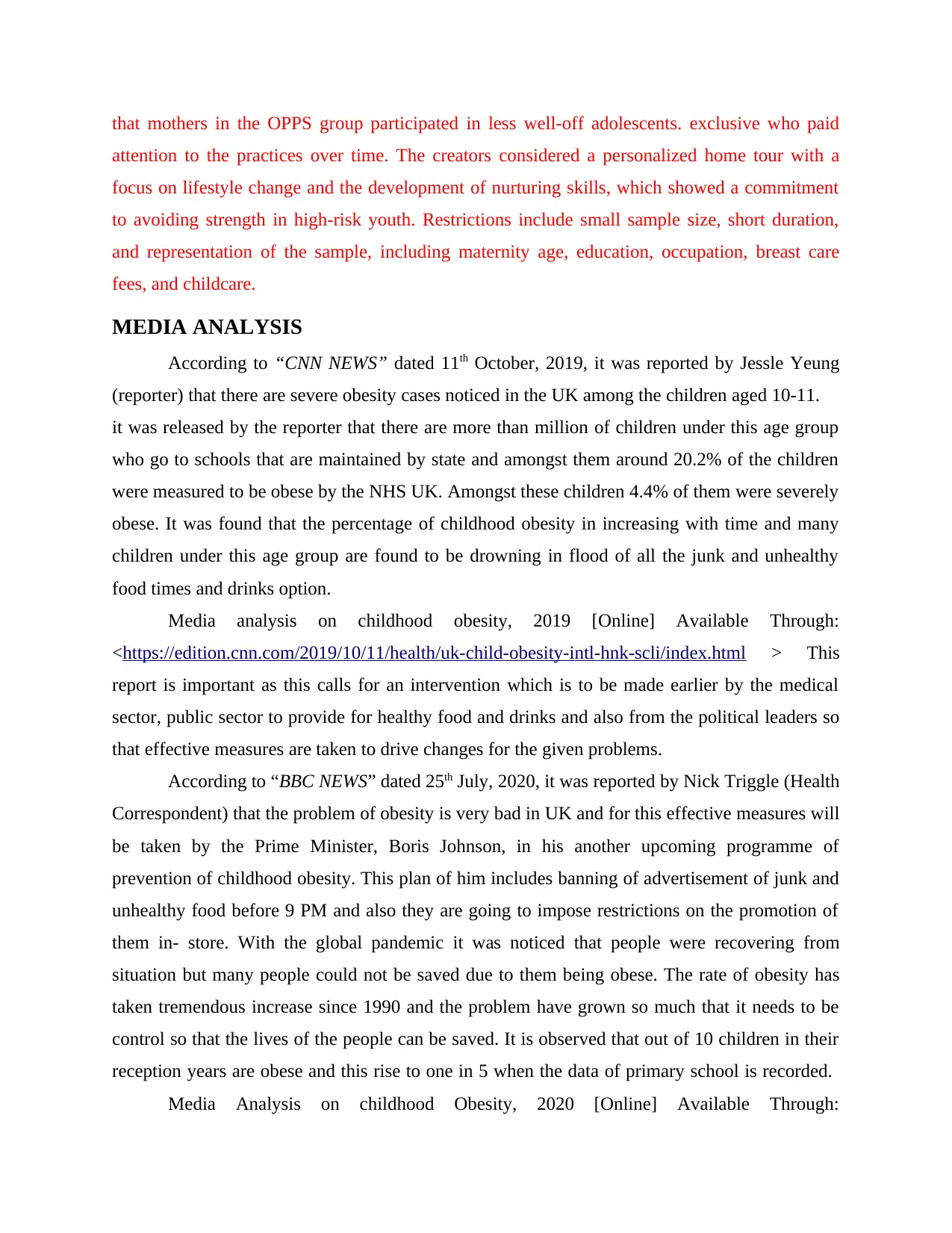
that mothers in the OPPS group participated in less well-off adolescents. exclusive who paid
attention to the practices over time. The creators considered a personalized home tour with a
focus on lifestyle change and the development of nurturing skills, which showed a commitment
to avoiding strength in high-risk youth. Restrictions include small sample size, short duration,
and representation of the sample, including maternity age, education, occupation, breast care
fees, and childcare.
MEDIA ANALYSIS
According to “CNN NEWS” dated 11th October, 2019, it was reported by Jessle Yeung
(reporter) that there are severe obesity cases noticed in the UK among the children aged 10-11.
it was released by the reporter that there are more than million of children under this age group
who go to schools that are maintained by state and amongst them around 20.2% of the children
were measured to be obese by the NHS UK. Amongst these children 4.4% of them were severely
obese. It was found that the percentage of childhood obesity in increasing with time and many
children under this age group are found to be drowning in flood of all the junk and unhealthy
food times and drinks option.
Media analysis on childhood obesity, 2019 [Online] Available Through:
<https://edition.cnn.com/2019/10/11/health/uk-child-obesity-intl-hnk-scli/index.html > This
report is important as this calls for an intervention which is to be made earlier by the medical
sector, public sector to provide for healthy food and drinks and also from the political leaders so
that effective measures are taken to drive changes for the given problems.
According to “BBC NEWS” dated 25th July, 2020, it was reported by Nick Triggle (Health
Correspondent) that the problem of obesity is very bad in UK and for this effective measures will
be taken by the Prime Minister, Boris Johnson, in his another upcoming programme of
prevention of childhood obesity. This plan of him includes banning of advertisement of junk and
unhealthy food before 9 PM and also they are going to impose restrictions on the promotion of
them in- store. With the global pandemic it was noticed that people were recovering from
situation but many people could not be saved due to them being obese. The rate of obesity has
taken tremendous increase since 1990 and the problem have grown so much that it needs to be
control so that the lives of the people can be saved. It is observed that out of 10 children in their
reception years are obese and this rise to one in 5 when the data of primary school is recorded.
Media Analysis on childhood Obesity, 2020 [Online] Available Through:
attention to the practices over time. The creators considered a personalized home tour with a
focus on lifestyle change and the development of nurturing skills, which showed a commitment
to avoiding strength in high-risk youth. Restrictions include small sample size, short duration,
and representation of the sample, including maternity age, education, occupation, breast care
fees, and childcare.
MEDIA ANALYSIS
According to “CNN NEWS” dated 11th October, 2019, it was reported by Jessle Yeung
(reporter) that there are severe obesity cases noticed in the UK among the children aged 10-11.
it was released by the reporter that there are more than million of children under this age group
who go to schools that are maintained by state and amongst them around 20.2% of the children
were measured to be obese by the NHS UK. Amongst these children 4.4% of them were severely
obese. It was found that the percentage of childhood obesity in increasing with time and many
children under this age group are found to be drowning in flood of all the junk and unhealthy
food times and drinks option.
Media analysis on childhood obesity, 2019 [Online] Available Through:
<https://edition.cnn.com/2019/10/11/health/uk-child-obesity-intl-hnk-scli/index.html > This
report is important as this calls for an intervention which is to be made earlier by the medical
sector, public sector to provide for healthy food and drinks and also from the political leaders so
that effective measures are taken to drive changes for the given problems.
According to “BBC NEWS” dated 25th July, 2020, it was reported by Nick Triggle (Health
Correspondent) that the problem of obesity is very bad in UK and for this effective measures will
be taken by the Prime Minister, Boris Johnson, in his another upcoming programme of
prevention of childhood obesity. This plan of him includes banning of advertisement of junk and
unhealthy food before 9 PM and also they are going to impose restrictions on the promotion of
them in- store. With the global pandemic it was noticed that people were recovering from
situation but many people could not be saved due to them being obese. The rate of obesity has
taken tremendous increase since 1990 and the problem have grown so much that it needs to be
control so that the lives of the people can be saved. It is observed that out of 10 children in their
reception years are obese and this rise to one in 5 when the data of primary school is recorded.
Media Analysis on childhood Obesity, 2020 [Online] Available Through:

<https://www.bbc.com/news/health-53514170 > This report is important as this states that the
government are planning to take effective measures in UK so that the childhood obesity is
controlled. The number of children facing this problem are increasing with every analysis done
by the government. Therefore high need of it to be prevented is observed.
REFLECTIVE STATEMENT
As a researcher, I have analysed that the childhood obesity is a very major problem which
bis growing rapidly in children as the children are being exposed to various food options which
are mostly unhealthy and junk. Children should not be given such exposure by their parents and
also the schools must look for it that the children are eating healthy and nutritious food in school.
People are taking this very casually and I think that individuals especially with those having
genetic obesity issues and are having kids, must indulge themselves in programs to create
awareness of childhood obesity so that their children do not face such problems. There are many
causes by which the obesity is increasing and it must be acknowledged by all the children, their
parents and schools. This will help in preventing it by taking effective measure. Not only parents
and children but schools also plays a very important role on the health and development of
children. The schools must encourage students or children to participate at least in one physical
activity.
I believe that with advancement in technology and innovations, there are many gadgets
and games available for children to play and kill their time. Due to this they lack interest in
outdoor activities or any kind of physical activity which leads to causing obesity. I strongly
believe that children if encouraged to play outside and get themselves involved in physical
games and activities, it will help them to grow more and develop. As a researcher, I feel that
giving exposure to children is good but instead of allowing them junk and unhealthy food,
parents should provide them with food options in variety that are all healthy, nutritious and tasty.
This will create interest in children to eat healthy food.
RESEARCH PROPOSAL
Title of the research project
“ To identify the issues pertaining to childhood obesity”
government are planning to take effective measures in UK so that the childhood obesity is
controlled. The number of children facing this problem are increasing with every analysis done
by the government. Therefore high need of it to be prevented is observed.
REFLECTIVE STATEMENT
As a researcher, I have analysed that the childhood obesity is a very major problem which
bis growing rapidly in children as the children are being exposed to various food options which
are mostly unhealthy and junk. Children should not be given such exposure by their parents and
also the schools must look for it that the children are eating healthy and nutritious food in school.
People are taking this very casually and I think that individuals especially with those having
genetic obesity issues and are having kids, must indulge themselves in programs to create
awareness of childhood obesity so that their children do not face such problems. There are many
causes by which the obesity is increasing and it must be acknowledged by all the children, their
parents and schools. This will help in preventing it by taking effective measure. Not only parents
and children but schools also plays a very important role on the health and development of
children. The schools must encourage students or children to participate at least in one physical
activity.
I believe that with advancement in technology and innovations, there are many gadgets
and games available for children to play and kill their time. Due to this they lack interest in
outdoor activities or any kind of physical activity which leads to causing obesity. I strongly
believe that children if encouraged to play outside and get themselves involved in physical
games and activities, it will help them to grow more and develop. As a researcher, I feel that
giving exposure to children is good but instead of allowing them junk and unhealthy food,
parents should provide them with food options in variety that are all healthy, nutritious and tasty.
This will create interest in children to eat healthy food.
RESEARCH PROPOSAL
Title of the research project
“ To identify the issues pertaining to childhood obesity”
Paraphrase This Document
Need a fresh take? Get an instant paraphrase of this document with our AI Paraphraser
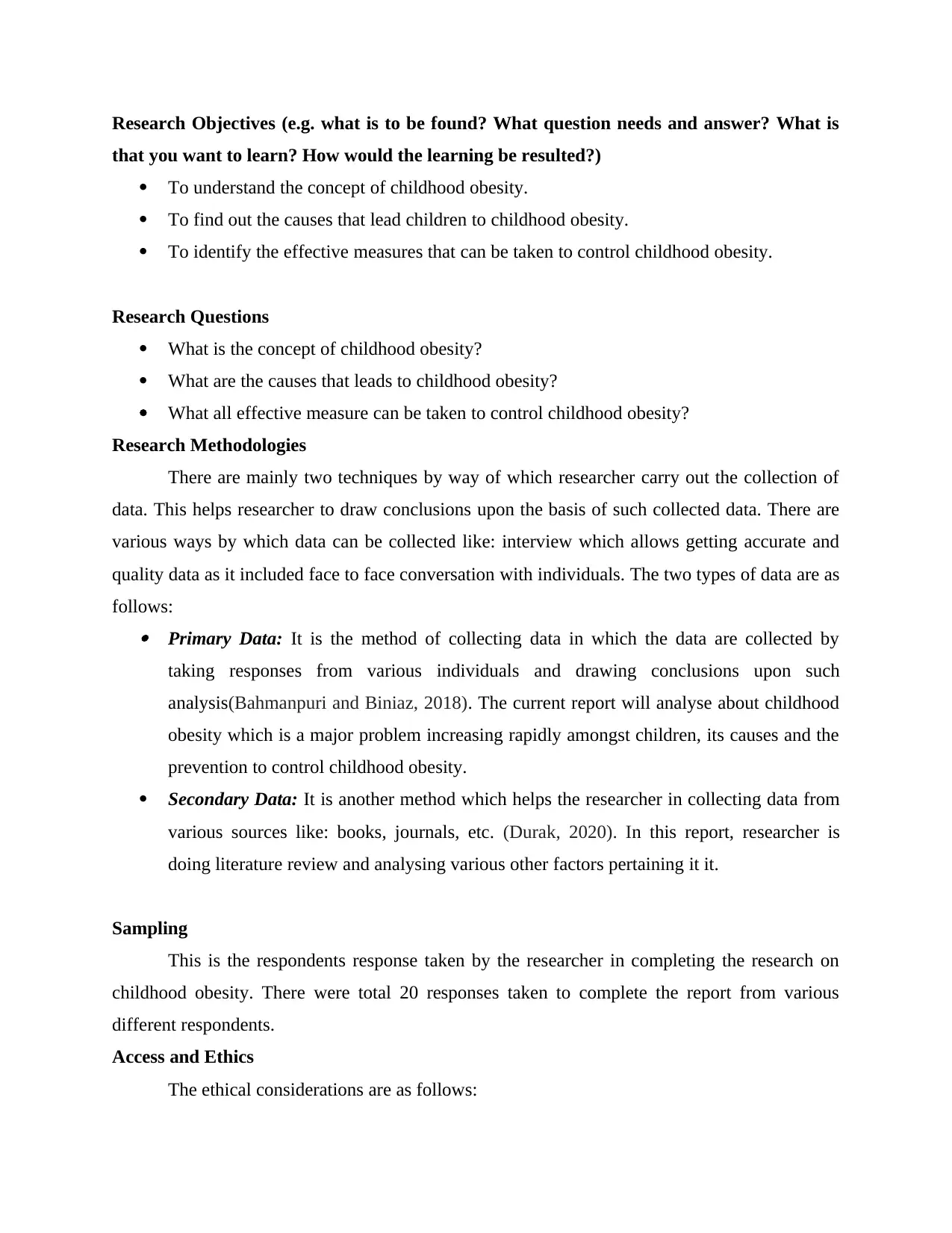
Research Objectives (e.g. what is to be found? What question needs and answer? What is
that you want to learn? How would the learning be resulted?)
To understand the concept of childhood obesity.
To find out the causes that lead children to childhood obesity.
To identify the effective measures that can be taken to control childhood obesity.
Research Questions
What is the concept of childhood obesity?
What are the causes that leads to childhood obesity?
What all effective measure can be taken to control childhood obesity?
Research Methodologies
There are mainly two techniques by way of which researcher carry out the collection of
data. This helps researcher to draw conclusions upon the basis of such collected data. There are
various ways by which data can be collected like: interview which allows getting accurate and
quality data as it included face to face conversation with individuals. The two types of data are as
follows: Primary Data: It is the method of collecting data in which the data are collected by
taking responses from various individuals and drawing conclusions upon such
analysis(Bahmanpuri and Biniaz, 2018). The current report will analyse about childhood
obesity which is a major problem increasing rapidly amongst children, its causes and the
prevention to control childhood obesity.
Secondary Data: It is another method which helps the researcher in collecting data from
various sources like: books, journals, etc. (Durak, 2020). In this report, researcher is
doing literature review and analysing various other factors pertaining it it.
Sampling
This is the respondents response taken by the researcher in completing the research on
childhood obesity. There were total 20 responses taken to complete the report from various
different respondents.
Access and Ethics
The ethical considerations are as follows:
that you want to learn? How would the learning be resulted?)
To understand the concept of childhood obesity.
To find out the causes that lead children to childhood obesity.
To identify the effective measures that can be taken to control childhood obesity.
Research Questions
What is the concept of childhood obesity?
What are the causes that leads to childhood obesity?
What all effective measure can be taken to control childhood obesity?
Research Methodologies
There are mainly two techniques by way of which researcher carry out the collection of
data. This helps researcher to draw conclusions upon the basis of such collected data. There are
various ways by which data can be collected like: interview which allows getting accurate and
quality data as it included face to face conversation with individuals. The two types of data are as
follows: Primary Data: It is the method of collecting data in which the data are collected by
taking responses from various individuals and drawing conclusions upon such
analysis(Bahmanpuri and Biniaz, 2018). The current report will analyse about childhood
obesity which is a major problem increasing rapidly amongst children, its causes and the
prevention to control childhood obesity.
Secondary Data: It is another method which helps the researcher in collecting data from
various sources like: books, journals, etc. (Durak, 2020). In this report, researcher is
doing literature review and analysing various other factors pertaining it it.
Sampling
This is the respondents response taken by the researcher in completing the research on
childhood obesity. There were total 20 responses taken to complete the report from various
different respondents.
Access and Ethics
The ethical considerations are as follows:
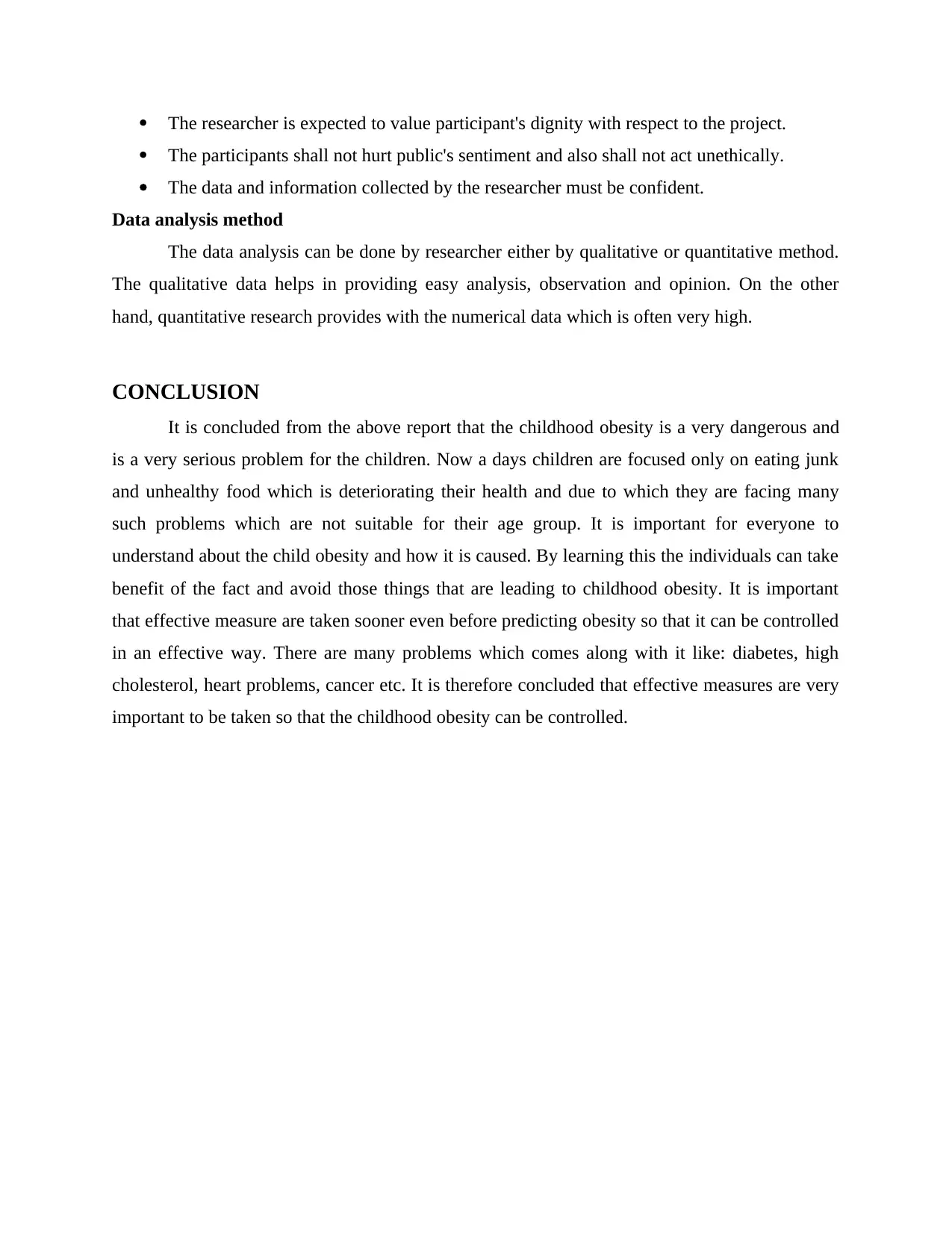
The researcher is expected to value participant's dignity with respect to the project.
The participants shall not hurt public's sentiment and also shall not act unethically.
The data and information collected by the researcher must be confident.
Data analysis method
The data analysis can be done by researcher either by qualitative or quantitative method.
The qualitative data helps in providing easy analysis, observation and opinion. On the other
hand, quantitative research provides with the numerical data which is often very high.
CONCLUSION
It is concluded from the above report that the childhood obesity is a very dangerous and
is a very serious problem for the children. Now a days children are focused only on eating junk
and unhealthy food which is deteriorating their health and due to which they are facing many
such problems which are not suitable for their age group. It is important for everyone to
understand about the child obesity and how it is caused. By learning this the individuals can take
benefit of the fact and avoid those things that are leading to childhood obesity. It is important
that effective measure are taken sooner even before predicting obesity so that it can be controlled
in an effective way. There are many problems which comes along with it like: diabetes, high
cholesterol, heart problems, cancer etc. It is therefore concluded that effective measures are very
important to be taken so that the childhood obesity can be controlled.
The participants shall not hurt public's sentiment and also shall not act unethically.
The data and information collected by the researcher must be confident.
Data analysis method
The data analysis can be done by researcher either by qualitative or quantitative method.
The qualitative data helps in providing easy analysis, observation and opinion. On the other
hand, quantitative research provides with the numerical data which is often very high.
CONCLUSION
It is concluded from the above report that the childhood obesity is a very dangerous and
is a very serious problem for the children. Now a days children are focused only on eating junk
and unhealthy food which is deteriorating their health and due to which they are facing many
such problems which are not suitable for their age group. It is important for everyone to
understand about the child obesity and how it is caused. By learning this the individuals can take
benefit of the fact and avoid those things that are leading to childhood obesity. It is important
that effective measure are taken sooner even before predicting obesity so that it can be controlled
in an effective way. There are many problems which comes along with it like: diabetes, high
cholesterol, heart problems, cancer etc. It is therefore concluded that effective measures are very
important to be taken so that the childhood obesity can be controlled.
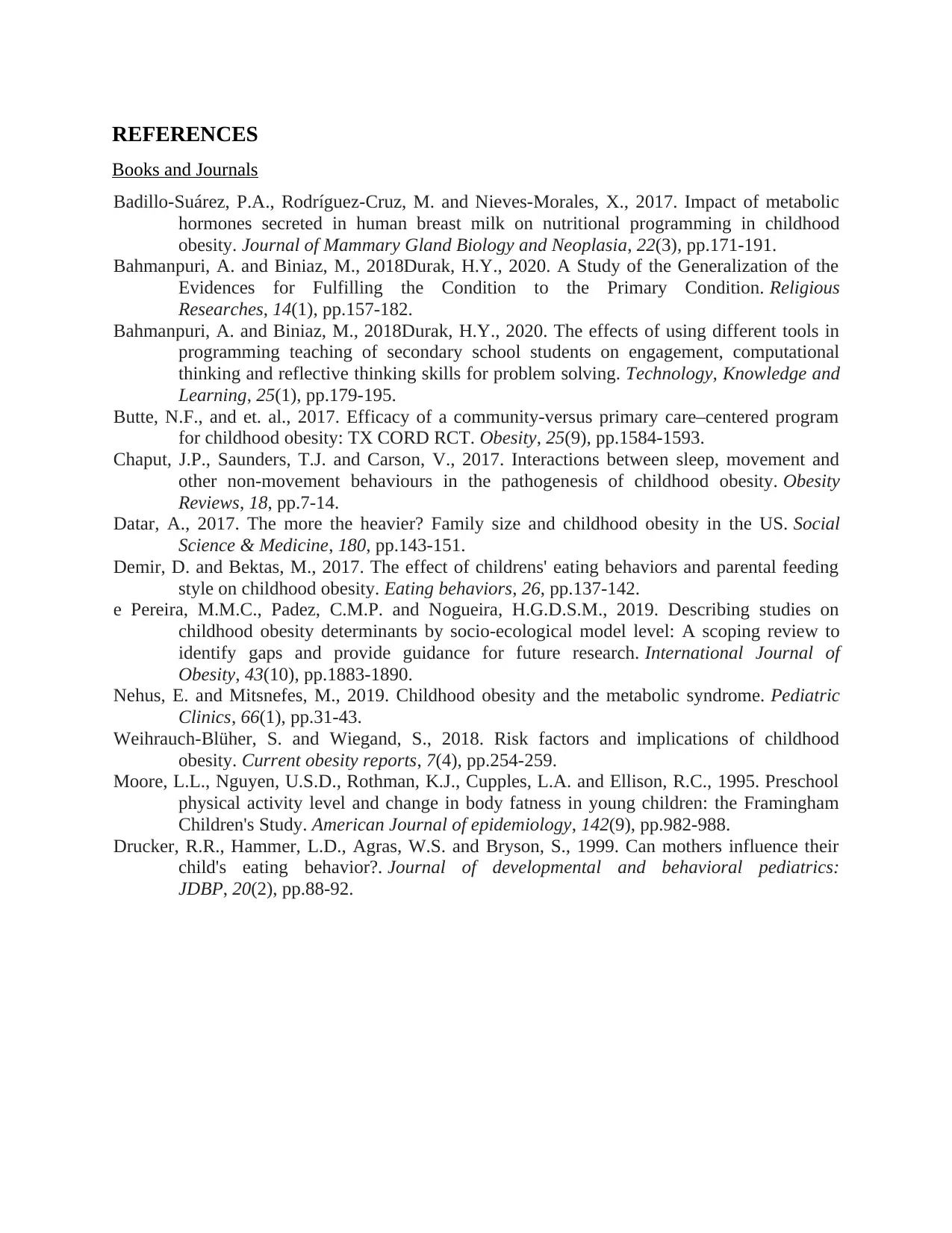
REFERENCES
Books and Journals
Badillo-Suárez, P.A., Rodríguez-Cruz, M. and Nieves-Morales, X., 2017. Impact of metabolic
hormones secreted in human breast milk on nutritional programming in childhood
obesity. Journal of Mammary Gland Biology and Neoplasia, 22(3), pp.171-191.
Bahmanpuri, A. and Biniaz, M., 2018Durak, H.Y., 2020. A Study of the Generalization of the
Evidences for Fulfilling the Condition to the Primary Condition. Religious
Researches, 14(1), pp.157-182.
Bahmanpuri, A. and Biniaz, M., 2018Durak, H.Y., 2020. The effects of using different tools in
programming teaching of secondary school students on engagement, computational
thinking and reflective thinking skills for problem solving. Technology, Knowledge and
Learning, 25(1), pp.179-195.
Butte, N.F., and et. al., 2017. Efficacy of a community‐versus primary care–centered program
for childhood obesity: TX CORD RCT. Obesity, 25(9), pp.1584-1593.
Chaput, J.P., Saunders, T.J. and Carson, V., 2017. Interactions between sleep, movement and
other non‐movement behaviours in the pathogenesis of childhood obesity. Obesity
Reviews, 18, pp.7-14.
Datar, A., 2017. The more the heavier? Family size and childhood obesity in the US. Social
Science & Medicine, 180, pp.143-151.
Demir, D. and Bektas, M., 2017. The effect of childrens' eating behaviors and parental feeding
style on childhood obesity. Eating behaviors, 26, pp.137-142.
e Pereira, M.M.C., Padez, C.M.P. and Nogueira, H.G.D.S.M., 2019. Describing studies on
childhood obesity determinants by socio-ecological model level: A scoping review to
identify gaps and provide guidance for future research. International Journal of
Obesity, 43(10), pp.1883-1890.
Nehus, E. and Mitsnefes, M., 2019. Childhood obesity and the metabolic syndrome. Pediatric
Clinics, 66(1), pp.31-43.
Weihrauch-Blüher, S. and Wiegand, S., 2018. Risk factors and implications of childhood
obesity. Current obesity reports, 7(4), pp.254-259.
Moore, L.L., Nguyen, U.S.D., Rothman, K.J., Cupples, L.A. and Ellison, R.C., 1995. Preschool
physical activity level and change in body fatness in young children: the Framingham
Children's Study. American Journal of epidemiology, 142(9), pp.982-988.
Drucker, R.R., Hammer, L.D., Agras, W.S. and Bryson, S., 1999. Can mothers influence their
child's eating behavior?. Journal of developmental and behavioral pediatrics:
JDBP, 20(2), pp.88-92.
Books and Journals
Badillo-Suárez, P.A., Rodríguez-Cruz, M. and Nieves-Morales, X., 2017. Impact of metabolic
hormones secreted in human breast milk on nutritional programming in childhood
obesity. Journal of Mammary Gland Biology and Neoplasia, 22(3), pp.171-191.
Bahmanpuri, A. and Biniaz, M., 2018Durak, H.Y., 2020. A Study of the Generalization of the
Evidences for Fulfilling the Condition to the Primary Condition. Religious
Researches, 14(1), pp.157-182.
Bahmanpuri, A. and Biniaz, M., 2018Durak, H.Y., 2020. The effects of using different tools in
programming teaching of secondary school students on engagement, computational
thinking and reflective thinking skills for problem solving. Technology, Knowledge and
Learning, 25(1), pp.179-195.
Butte, N.F., and et. al., 2017. Efficacy of a community‐versus primary care–centered program
for childhood obesity: TX CORD RCT. Obesity, 25(9), pp.1584-1593.
Chaput, J.P., Saunders, T.J. and Carson, V., 2017. Interactions between sleep, movement and
other non‐movement behaviours in the pathogenesis of childhood obesity. Obesity
Reviews, 18, pp.7-14.
Datar, A., 2017. The more the heavier? Family size and childhood obesity in the US. Social
Science & Medicine, 180, pp.143-151.
Demir, D. and Bektas, M., 2017. The effect of childrens' eating behaviors and parental feeding
style on childhood obesity. Eating behaviors, 26, pp.137-142.
e Pereira, M.M.C., Padez, C.M.P. and Nogueira, H.G.D.S.M., 2019. Describing studies on
childhood obesity determinants by socio-ecological model level: A scoping review to
identify gaps and provide guidance for future research. International Journal of
Obesity, 43(10), pp.1883-1890.
Nehus, E. and Mitsnefes, M., 2019. Childhood obesity and the metabolic syndrome. Pediatric
Clinics, 66(1), pp.31-43.
Weihrauch-Blüher, S. and Wiegand, S., 2018. Risk factors and implications of childhood
obesity. Current obesity reports, 7(4), pp.254-259.
Moore, L.L., Nguyen, U.S.D., Rothman, K.J., Cupples, L.A. and Ellison, R.C., 1995. Preschool
physical activity level and change in body fatness in young children: the Framingham
Children's Study. American Journal of epidemiology, 142(9), pp.982-988.
Drucker, R.R., Hammer, L.D., Agras, W.S. and Bryson, S., 1999. Can mothers influence their
child's eating behavior?. Journal of developmental and behavioral pediatrics:
JDBP, 20(2), pp.88-92.
1 out of 10
Related Documents
Your All-in-One AI-Powered Toolkit for Academic Success.
+13062052269
info@desklib.com
Available 24*7 on WhatsApp / Email
![[object Object]](/_next/static/media/star-bottom.7253800d.svg)
Unlock your academic potential
© 2024 | Zucol Services PVT LTD | All rights reserved.





